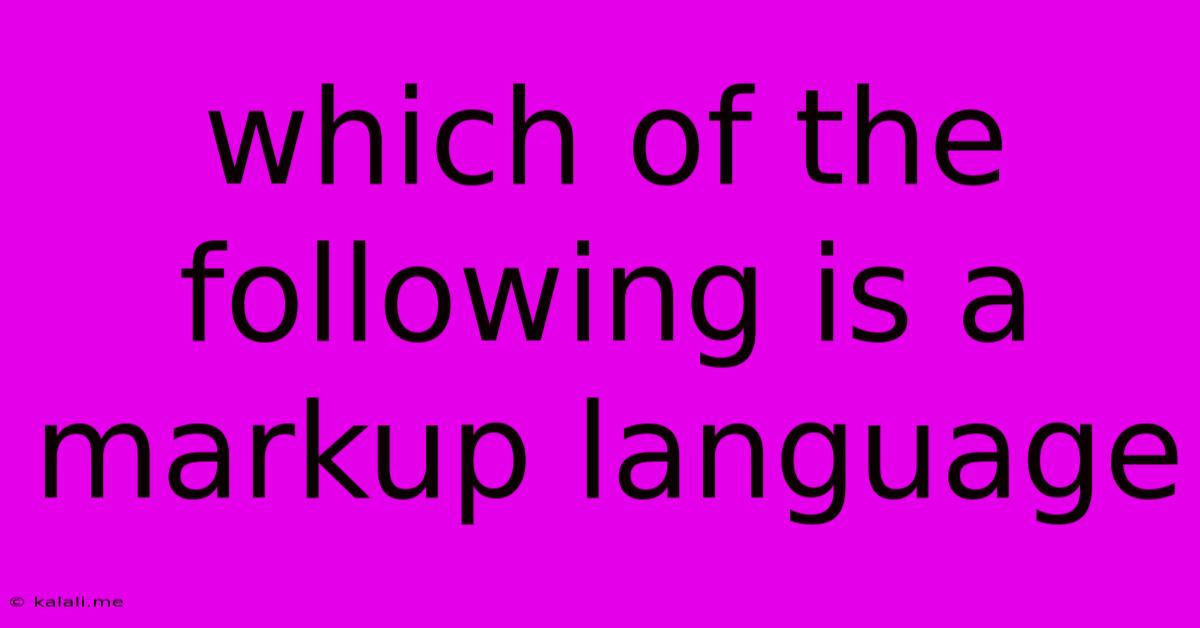Which Of The Following Is A Markup Language
Kalali
Jun 13, 2025 · 3 min read

Table of Contents
Which of the Following is a Markup Language? Understanding Markup Languages and Their Applications
This article will explore the concept of markup languages, clarifying what they are and distinguishing them from other programming paradigms. We'll delve into several examples to solidify your understanding and help you confidently identify a markup language when you encounter one. This is crucial for anyone involved in web development, data management, or document creation.
What is a Markup Language?
A markup language is a system for annotating a document in a way that is understandable by both humans and computers. It uses tags to structure and describe the content, rather than specifying how the content should be displayed or processed. Think of it as adding metadata to your text, providing context and instructions for how the data should be interpreted. Unlike programming languages, markup languages don't execute instructions; they describe the structure and semantics of the data. This is a key differentiating factor.
Key Characteristics of Markup Languages:
- Tags: These are the core components, enclosed in angle brackets (
< >). They provide instructions about the elements within the document. For example,<h1>indicates a level-one heading. - Structure and Semantics: Markup languages focus on structuring the content logically and adding semantic meaning. They describe what the data is, not how it should be presented visually.
- Human-Readable: While computers parse the tags, markup languages are designed to be relatively easy for humans to read and understand.
- Not executable: Unlike programming languages like Python or JavaScript, markup languages don't contain executable code.
Examples of Markup Languages:
Let's examine some common examples to illustrate the concept:
-
HTML (HyperText Markup Language): This is the foundational language of the World Wide Web, used to structure and present content on websites. You see HTML at work every time you visit a webpage. Tags like
<p>(paragraph),<h1>(heading), and<img>(image) define the content structure. -
XML (Extensible Markup Language): XML is a more general-purpose markup language used to store and transport data. It's highly flexible and allows you to define your own custom tags, making it suitable for a wide variety of applications, including configuration files and data exchange between systems.
-
XHTML (Extensible HyperText Markup Language): This is a stricter, XML-compliant version of HTML. It uses XML syntax rules and is designed for better validation and interoperability.
-
SGML (Standard Generalized Markup Language): This is a more general and powerful ancestor of XML and HTML. It's used for complex document structures.
Differentiating Markup from Programming Languages:
It's essential to distinguish between markup and programming languages. While both involve code, their purposes are fundamentally different:
- Markup languages describe the structure and semantics of data.
- Programming languages provide instructions to a computer to perform actions and manipulate data.
For instance, JavaScript is a programming language used to add interactivity and dynamic behavior to websites. It works in conjunction with HTML (a markup language), but it's not a markup language itself. Similarly, Python, while powerful for various tasks including web development, is not a markup language.
Conclusion:
Understanding the nature of markup languages is crucial for anyone working with digital content. Their ability to structure and semantically enrich data forms the basis of much of the digital world we experience daily. By recognizing the defining features—tags, focus on structure and semantics, and lack of executability—you can confidently identify and utilize these powerful tools effectively.
Latest Posts
Latest Posts
-
A Quadrilateral Pqrs Is Inscribed In A Circle
Jun 14, 2025
-
The Key Distinction Between Positive And Negative Reinforcement Is
Jun 14, 2025
-
Which Is Not A Part Of Respiratory System
Jun 14, 2025
-
Which Of The Following Is A Percussion Instrument
Jun 14, 2025
-
The First 15 Elements Of Periodic Table
Jun 14, 2025
Related Post
Thank you for visiting our website which covers about Which Of The Following Is A Markup Language . We hope the information provided has been useful to you. Feel free to contact us if you have any questions or need further assistance. See you next time and don't miss to bookmark.